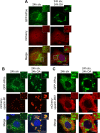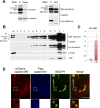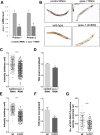Spastin binds to lipid droplets and affects lipid metabolism
- PMID: 25875445
- PMCID: PMC4395272
- DOI: 10.1371/journal.pgen.1005149
Spastin binds to lipid droplets and affects lipid metabolism
Abstract
Mutations in SPAST, encoding spastin, are the most common cause of autosomal dominant hereditary spastic paraplegia (HSP). HSP is characterized by weakness and spasticity of the lower limbs, owing to progressive retrograde degeneration of the long corticospinal axons. Spastin is a conserved microtubule (MT)-severing protein, involved in processes requiring rearrangement of the cytoskeleton in concert to membrane remodeling, such as neurite branching, axonal growth, midbody abscission, and endosome tubulation. Two isoforms of spastin are synthesized from alternative initiation codons (M1 and M87). We now show that spastin-M1 can sort from the endoplasmic reticulum (ER) to pre- and mature lipid droplets (LDs). A hydrophobic motif comprised of amino acids 57 through 86 of spastin was sufficient to direct a reporter protein to LDs, while mutation of arginine 65 to glycine abolished LD targeting. Increased levels of spastin-M1 expression reduced the number but increased the size of LDs. Expression of a mutant unable to bind and sever MTs caused clustering of LDs. Consistent with these findings, ubiquitous overexpression of Dspastin in Drosophila led to bigger and less numerous LDs in the fat bodies and increased triacylglycerol levels. In contrast, Dspastin overexpression increased LD number when expressed specifically in skeletal muscles or nerves. Downregulation of Dspastin and expression of a dominant-negative variant decreased LD number in Drosophila nerves, skeletal muscle and fat bodies, and reduced triacylglycerol levels in the larvae. Moreover, we found reduced amount of fat stores in intestinal cells of worms in which the spas-1 homologue was either depleted by RNA interference or deleted. Taken together, our data uncovers an evolutionarily conserved role of spastin as a positive regulator of LD metabolism and open up the possibility that dysfunction of LDs in axons may contribute to the pathogenesis of HSP.
Conflict of interest statement
The authors have declared that no competing interests exist.
Figures








Similar articles
-
Hereditary spastic paraplegia SPG4: what is known and not known about the disease.Brain. 2015 Sep;138(Pt 9):2471-84. doi: 10.1093/brain/awv178. Epub 2015 Jun 20. Brain. 2015. PMID: 26094131 Free PMC article. Review.
-
Microtubule-dependent and independent roles of spastin in lipid droplet dispersion and biogenesis.Life Sci Alliance. 2020 Apr 22;3(6):e202000715. doi: 10.26508/lsa.202000715. Print 2020 Jun. Life Sci Alliance. 2020. PMID: 32321733 Free PMC article.
-
Spastin tethers lipid droplets to peroxisomes and directs fatty acid trafficking through ESCRT-III.J Cell Biol. 2019 Aug 5;218(8):2583-2599. doi: 10.1083/jcb.201902061. Epub 2019 Jun 21. J Cell Biol. 2019. PMID: 31227594 Free PMC article.
-
Disease-related phenotypes in a Drosophila model of hereditary spastic paraplegia are ameliorated by treatment with vinblastine.J Clin Invest. 2005 Nov;115(11):3026-34. doi: 10.1172/JCI24694. J Clin Invest. 2005. PMID: 16276413 Free PMC article.
-
The AAA ATPase spastin links microtubule severing to membrane modelling.Biochim Biophys Acta. 2012 Jan;1823(1):192-7. doi: 10.1016/j.bbamcr.2011.08.010. Epub 2011 Aug 25. Biochim Biophys Acta. 2012. PMID: 21888932 Review.
Cited by
-
Spastin mutations impair coordination between lipid droplet dispersion and reticulum.PLoS Genet. 2020 Apr 21;16(4):e1008665. doi: 10.1371/journal.pgen.1008665. eCollection 2020 Apr. PLoS Genet. 2020. PMID: 32315314 Free PMC article.
-
Unraveling Isoform Complexity: The Roles of M1- and M87-Spastin in Spastic Paraplegia 4 (SPG4).Mov Disord. 2025 Mar;40(3):420-430. doi: 10.1002/mds.30072. Epub 2024 Nov 29. Mov Disord. 2025. PMID: 39614608 Review.
-
Lipid metabolic pathways converge in motor neuron degenerative diseases.Brain. 2020 Apr 1;143(4):1073-1087. doi: 10.1093/brain/awz382. Brain. 2020. PMID: 31848577 Free PMC article. Review.
-
Neuronal lipolysis participates in PUFA-mediated neural function and neurodegeneration.EMBO Rep. 2020 Nov 5;21(11):e50214. doi: 10.15252/embr.202050214. Epub 2020 Oct 9. EMBO Rep. 2020. PMID: 33034119 Free PMC article.
-
Adaptive and maladaptive roles of lipid droplets in health and disease.Am J Physiol Cell Physiol. 2022 Mar 1;322(3):C468-C481. doi: 10.1152/ajpcell.00239.2021. Epub 2022 Feb 2. Am J Physiol Cell Physiol. 2022. PMID: 35108119 Free PMC article. Review.
References
-
- Ghadially FN. Ultrastructural Pathology Of the Cell and Matrix: Butterworths-Heinemann, Boston; 1988.
Publication types
MeSH terms
Substances
LinkOut - more resources
Full Text Sources
Other Literature Sources
Molecular Biology Databases
Research Materials

